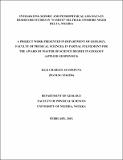UNNSpace Repository
Integrating Seismic and Petrophysical Log Data in Reservoir Studies in "Famito" Oil Field, Onshore Niger Delta, Nigeria
- UNNSpace Home
- →
- Faculty of Physical Sciences
- →
- Geology
- →
- Theses and Dissertations (Geology)
- →
- View Item
JavaScript is disabled for your browser. Some features of this site may not work without it.
| dc.contributor.author | Illo, Charles Afamefuna
|
|
| dc.date.accessioned | 2017-03-14T15:01:56Z | |
| dc.date.available | 2017-03-14T15:01:56Z | |
| dc.date.issued | 2017-03-14 | |
| dc.identifier.uri | http://hdl.handle.net/123456789/3904 | |
| dc.description.abstract | Reservoir characterization has taken prominence in hydrocarbon exploration due to its role in proper understanding of the reservoir properties such as lithofacies, and petrophysical parameters, to enhance success in the quantification of the hydrocarbon reserve in place thereby diminishing exploration failures and enhancing successes. This research work is aimed at integrating three-dimensional seismic data and petrophysical log data to characterize reservoirs of interest, map structures, delineate facies and interpret the various depositional environments in “FAMITO” field of Niger Delta. Mapping and interpretation of faults and horizons/reservoir tops were carried out across the seismic volume. Field-wide and intra-reservoir correlation (North-South direction), aided by gamma ray log, were carried out across the field of study. Three reservoir tops of interest (F-1000, G-1000, and H-1000 reservoirs), were delineated and correlated. Facies interpretations using the integration of biostratigraphic and well log data showed that the reservoirs have shoreface and channel sands. The environments of deposition encountered, spans from fluvial through shallow marine. Time structural maps generated from these tops were depth converted using the velocity model. Studies reveal hydrocarbon closures and prospects bounded by faults which constitute the main trapping mechanism across the study area. Petrophysical analysis shows that the average porosity and water saturation values for F-1000 reservoir is 0.2401 and 0.3866, G-1000 reservoir is 0.2527 and 0.4549, and that of H-1000 reservoir is 0.2436 and 0.2838 respectively. These values indicate that the identified prospective zones have good porosity and water saturation. Seismic attribute maps (root mean square (rms), maximum amplitude and average energy) generated from the time structural maps show the presence of hydrocarbon accumulation. Hence, this work has shown that integrated studies are critical in characterization of reservoirs in the onshore Niger Delta | en_US |
| dc.language.iso | en | en_US |
| dc.subject | Akata Formation | en_US |
| dc.subject | Petrophysical Log Data | en_US |
| dc.subject | Onshore Niger Delta | en_US |
| dc.subject | Seismic | en_US |
| dc.subject | Reservoir Studies | en_US |
| dc.subject | Famito" Oil Field | en_US |
| dc.title | Integrating Seismic and Petrophysical Log Data in Reservoir Studies in "Famito" Oil Field, Onshore Niger Delta, Nigeria | en_US |
| dc.type | Thesis | en_US |
